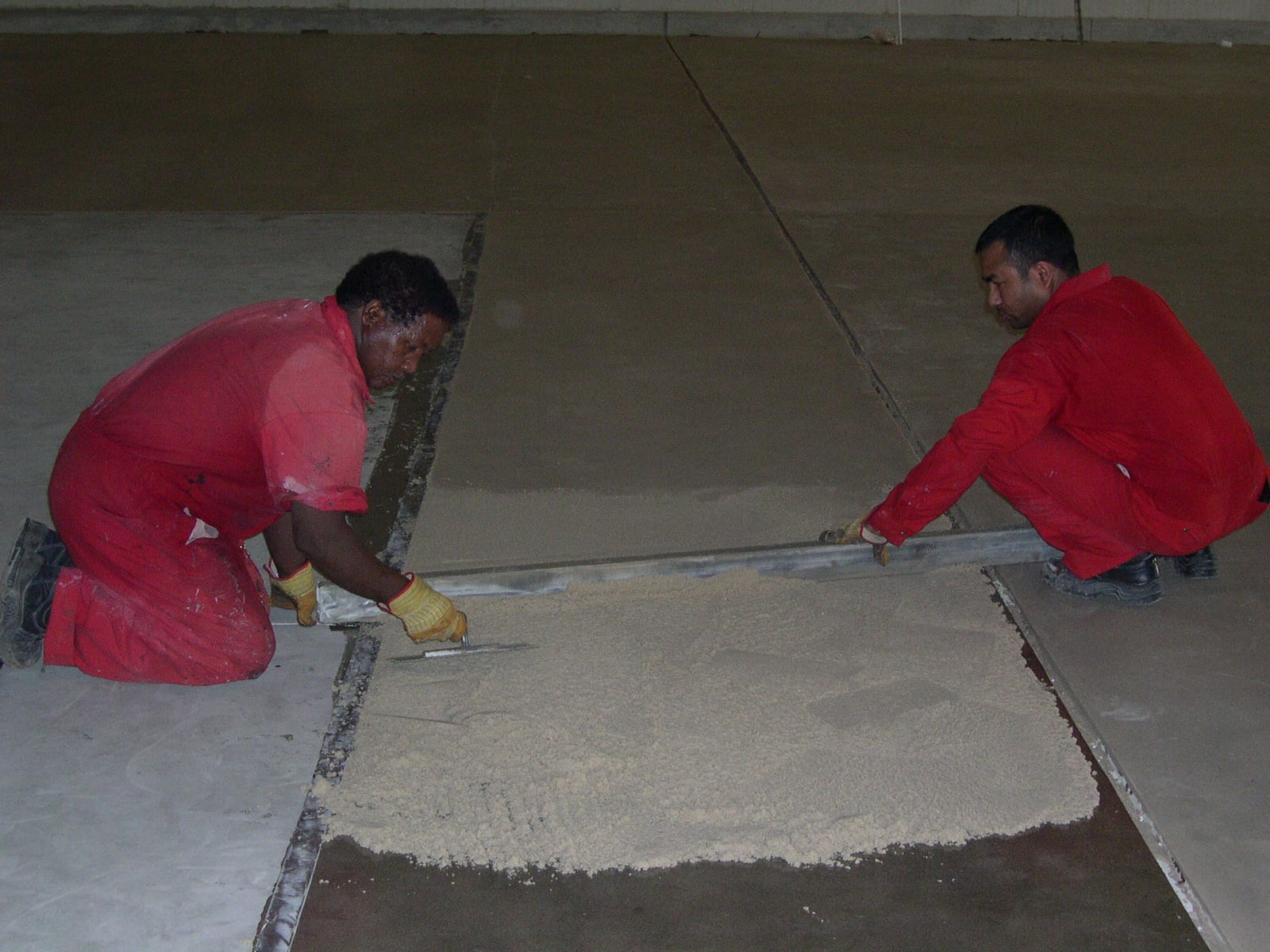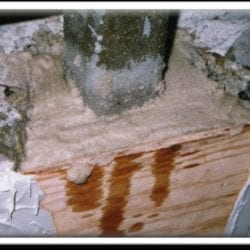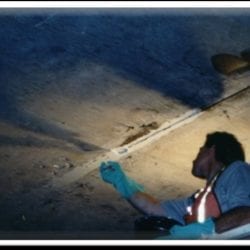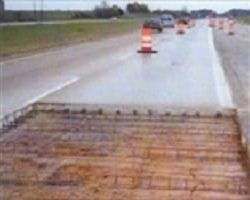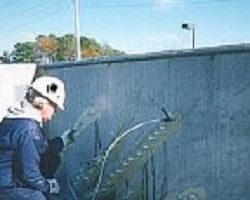USES
CHEM-MORTAR 2 epoxy binder system is designed for use as:
- Epoxy primer for epoxy bulk repair mortars, epoxy mortar screeds, etc.
- Binder for epoxy mortar screeds.
- Binder for epoxy repair mortars.
Epoxy repair mortars and floor toppings are formulated to desired consistency using dry, graded silica sands at given proportions
TECHNICAL
Technical Data for Unmixed Parts
| Property @ 25°C (77°F) |
Resin – Part A
|
Hardener – Part B |
Test Method
|
| Solids |
100 % |
100 % |
–
|
| Color |
Clear |
Clear |
–
|
| Density, Lb/Gal (Kg/L) |
9.7 (1.16) |
< 8.1 (0.97) |
ASTM D-1475 |
| Mixing Ratio A: B |
1: 1 By Volume |
–
|
| Shelf Life |
2 years |
2 years |
–
|
Technical Data for Mixed Parts*
| Property (Mixed A & B) |
Value @ 25°C (77°C) |
Test Method |
| Mixed Density, Lb/Gal (kg/L) |
8.92 (1.07) |
ASTM D-1475 |
| Viscosity, cP |
1600 |
Brookfield |
| Gel Time @ 5 mil, hour |
6 – 8 |
ASTM D-2471 |
| Pot Life @ 3 Oz (90 milliliter), minute |
38 |
ASTM C-881 |
| Shore Hardness @ 3 Days, D |
70 |
ASTM D-2240 |
| Compressive Strength, Psi (MPa) |
6500 (44.82) |
ASTM D-695 |
| Flexural Strength, Psi (MPa) |
4500 (31.03) |
ASTM D-790 |
| Tensile Strength, Psi (MPa) |
5000 (34.47) |
ASTM D-638 |
| Bond Strength to Concrete (Dry 2 Days), Psi (MPa) |
1600 (11.03) |
ASTM C-882 |
| Bond Strength to Concrete (Moist 14 Days), Psi (MPa) |
1500 (10.34) |
ASTM C-882 |
| Elongation (Average), % |
35 |
ASTM D-638 |
| Water Absorption 24 hrs, % |
0.6 |
ASTM D-570 |
| Final Cure, day |
7 |
–
|
* Test performed for epoxy without aggregate.
Chemical Resistance: Tests are performed according to ASTM D543 – Practice A (Immersion test for 7 days at 77°F/25°C). The fully cured product is resistant to:
- Water (Distilled, Tap, chlorinated, sewage, sea)
- Sulfuric acid 70%wt
- Sulfuric acid 50%wt
- Citric Acid, 30% wt
- Caustic Soda, 50% wt
- Hydrochloric acid, 38% wt
- Phosphoric Acid 85% wt
- Diesel
- Hydraulic Oil
Refer to manufacturer for resistance of other reagents.
APPLICATION
Limitations: application at ambient temperature below approximately 41F (5°C) is not recommended. Exposure to temperatures exceeding 149°F (65°C) for prolonged periods is not recommended.
Surface Preparation: concrete or cementitious substrates should be at least 28 days old and moisture content of substrate should be less than 5%.
All laitance and loose materials must be removed from the concrete surfaces. If the concrete is strong, crack-free and sound with light laitance, surface preparation may be achieved by acid etching followed by thorough water washing using high pressure water jetting ensuring all traces of acids are removed prior to application of the repair screed.
Areas or deeply penetrating contaminations by oil, greases and fats should be flame cleaned by hot compressed air or thoroughly washed by good industrial detergent. The cleanly washed substrate is then allowed to dry completely.
Cracked or damaged concrete or heavy laitance should be removed and prepared by grit blasting, scrabbling or mechanical grinding until a solid surface is reached showing exposed aggregate.
Any corroded reinforcement should be exposed at least 10 mm around the reinforcement and shot blasted to Swedish standard SA 2 ½ (bright metal).
Avoid featheredges in the concrete. Repair areas by saw cutting to a minimum depth of 5 mm. Remove all deleterious concrete until achieving a solid base. Blow out all the dust from the area of repair.
Mixing and Application: mechanical mixing of the CHEM-MORTAR 2 and silica sands is the most efficient and effective method. Stir each part separately. Mix equal volumes of Part A Resin and Part B Hardener thoroughly using slow speed hand held drill fitted with a mixing paddle attachment. Carefully scrape the sides and bottom of the mixing container during mixing. Blend for 1 to 2 minutes until achieving a uniform color and consistency. To use CHEM-MORTAR 2 as a mortar for repairs of spalls, honeycombs, etc., add dry graded silica sands and mix well before trowelling. The mix ration is 1 volume of the liquid mixture to 6 volumes of sand or approximately 2.2 Lb (1 kg) of liquid mixture to 22 Lb (10 Kg) graded silica sand. Density of the mixed mortar is approximately 14.19 Lb/Gallon (1.7 Kg/liter). Choice of silica sand size depends on the depth of the required repair. Consult our technical staff for recommendation on choices. Prior to application of CHEM-MORTAR 2 mortar, a primer must be applied to the substrate to insure bonding. Use resin and hardener of CHEM-MORTAR 2 binder system for priming. Trowel the mortar into a wet or tacky primer.
Curing: allow the system to cure for minimum 24 hours prior to subjecting it to use for light traffic. Heavy traffic and chemicals should not be allowed until after 7 days.
Cleaning: remove uncured CHEM-MORTAR 2 from tools and equipment with suitable solvents such as Xylene, Toluene or CHEM-CRETE BLENDED SOLVENT immediately after use. Cured material may only be removed mechanically.
STORAGE
The product can be stored for minimum of twelve months at temperature from 41°F to 95°F (5°C to 35°C) in the unopened original packaging. Protect from direct sunlight.
SAFETY
After hardening thoroughly, CHEM-MORTAR 2 is physiologically harmless. Keep the resin and hardener away from the eyes mouth and skin. Do not breathe in the vapors. The uncured mixture can cause irritation of the skin. For best protection, wear rubber or plastic gloves. In case of contamination, wipe away resin or hardener immediately from the skin using paper towels and then wash with soap and water or hand cleaning detergent. Empty resin and hardener cans must be disposed according to local city code or regulations. Under no circumstances empty cans should be used to store food or drink even if they have been thoroughly cleaned. Follow all cautionary direction as printed on container’s labels.
WARRANTY
LIMITED WARRANTY: International Chem-Crete Inc. warrants that, at the time and place we make shipment, our materials will be of good quality and will conform to our published specifications in force on the date of acceptance of the order.
DISCLAIMER: The information contained herein is included for illustrative purposes only and, to the best of our knowledge, is accurate and reliable. International Chem-Crete Inc. is not under any circumstances liable to connection with the use of information. As International Chem-Crete Inc. has no control over the use to which others may put its products, it is recommended that the products be tested to determine the suitability for specific applications and/or our information is valid in particular circumstances. Responsibility remains with the architect or engineer, contractor and owner of the design, application and proper installation of each product. Specifier and user shall determine the suitability of the product for specific application and assume all responsibility in connection therewith. AM270311

